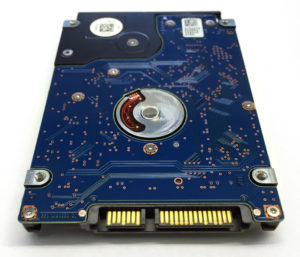
A hard drive’s Serial ATA (or SATA) connector allows storage media to interface with the computer. It’s essential to hard drive operation — and unfortunately, it’s an extremely fragile component. With a small amount of pressure, computer users can easily break their SATA connectors, which leaves the hard drive without a power or signal source or both.
At Datarecovery.com, we support consumers’ right to repair their own devices. However, replacing a broken SATA connector can be tricky. While SATA connectors are more-or-less standardized, they’re fused to the hard drive’s electronics board.
If you’ve lost data due to a broken SATA connector, we’re here to help. Contact us at 1-800-237-4200 to discuss the situation or read on for more information about SATA connection replacement.
Replacing a broken SATA connector usually means replacing the electronics board.
When people ask us about replacing broken SATA connectors, they’re usually not talking about just the connector — replacing a connector is risky, and replacing the entire printed circuit board (PCB) is relatively easy.
If you have a broken SATA connection, replacing your hard drive’s electronics board can resolve the issue. However, this isn’t a straightforward process. In most cases, you can’t successfully recover a hard drive by simply unscrewing the PCB and screwing another PCB into its place.
Why can’t I switch my hard drive’s PCB with an identical donor PCB?
In short: The hard drives aren’t actually identical, even if they have the same model number and firmware revision number.
Modern hard drives have NVRAM and/or EEPROM chips that contain drive-specific information. These chips are written at the factory during manufacturing and include parameters for the distances between the drives actuator head components. Manufacturers don’t create these drive-specific chips to discourage consumers from repairing their hard drives — the parameters of the NVRAM and EEPROM allow hard drives to operate reliably and allow for higher data densities.
In order for the new board to work, these components must be transferred to the donor board. If you don’t transfer the components, there’s a slim chance that the donor board’s EEPROM and NVRAM will be within the error tolerance (error tolerance varies from model to model).

This drive has intact SATA connectors
However, we wouldn’t take that chance if the hard drive contains important data. If the drive-specific components are damaged, you’ll need to recreate them — and that requires extremely specialized equipment that you’re unlikely to find outside of a professional data recovery laboratory.
I have soldering tools. Can I switch the NVRAM/EEPROM chips to fix my broken SATA connector?
Possibly, but the process for transferring the chips will vary from drive to drive. The components aren’t always located in the same place, and by moving them, you’ll be taking a risk.
That risk varies depending on the drive’s manufacturer, model number, and a few other factors. For Hitachi, Seagate, and Samsung hard drives, if you accidentally damage your hard drive’s EEPROM or NVRAM, you have virtually no chance of recovering the data.
Additionally, NVRAM and EEPROM chips are often tiny components. If you have soldering skills and access to a hot air station, you may be able to install the new chips on the board, but you’ll need plenty of practice before attempting this procedure.
Finding Affordable Data Recovery Options for Broken SATA Connectors
There’s another good reason to hold off on repairing your broken SATA connector: You probably won’t save much money.
As discussed above, hard drive PCB replacement requires a hot air station, soldering skills, and plenty of practice. If you don’t have these resources (or a half-dozen hard drives to experiment with before starting your attempt), you’ll end up investing quite a bit of time and money.
Here’s the good news: Broken SATA connectors are simple repairs for an experienced data recovery engineer. If there’s nothing else wrong with your hard drive, you’re facing a minimal recovery fee, provided that you’re working with a reputable provider.
At Datarecovery.com, we offer free evaluations for all physically damaged hard drives, along with a no data, no charge guarantee — if we’re not able to recover your data, you won’t pay for the attempt. For a free estimate, use our online form to start a case or call 1-800-237-4200.




